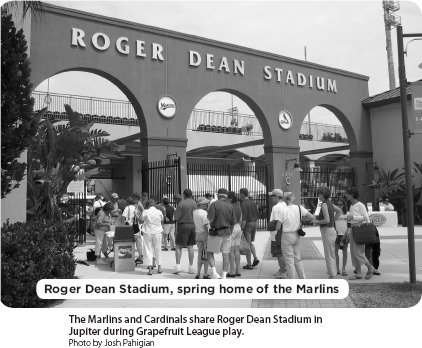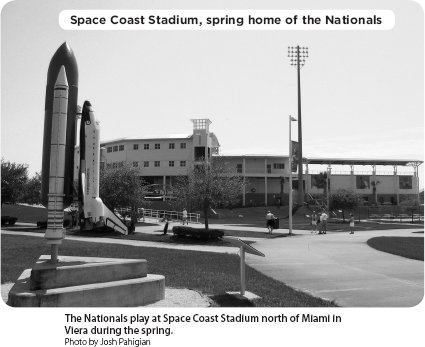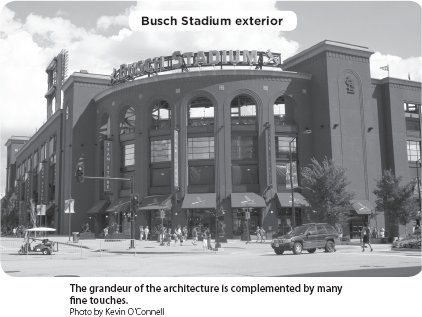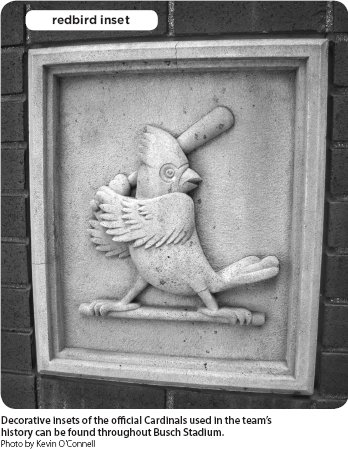Ultimate Baseball Road Trip (49 page)
Read Ultimate Baseball Road Trip Online
Authors: Josh Pahigian,Kevin O’Connell


Kevin Orchestrated a (Good-Natured) Kidnapping
We walked down a long pier toward a boat that Kevin had chartered weeks in advance, both happy to stretch our legs after a long drive across the many bridges that link the Florida Keys. We were in Key West, but not for long. In a few minutes we’d be on the high waters.
“So we’re finally going to do some fishing,” Josh said eagerly.
“Yup, I finally got the bug,” Kevin lied.
“I knew you’d come around,” Josh said.
“Talking about it incessantly is finally paying off for you,” Kevin said. “Tell me again about all the trout you and your friend Matt caught out of a storm drain.”
“Um, it was a lake drain,” Josh said. Then he launched into the story.
“I’ve been looking forward to this,” Josh said upon the completion of his story. And it was true: He had been looking forward to the side tour that he still believed would include fishing for marlin in the Gulf of Mexico and a three-night stay at a resort in Cancun.
“Me, too,” Kevin replied.
But as we approached the boat, Josh started to get suspicious. “This doesn’t look like a fishing charter at all,” he said. “It looks like a booze cruise ship.”
“Have you ever been deep-sea fishing?” Kevin asked.
“Yeah, all the time,” Josh said.
“But have you ever been on a marlin boat?”
“Well, no,” Josh admitted.
“Then just get on the boat.”
And so we boarded the large vessel along with the other tourists, none of whom, Josh noted, had fishing gear among their luggage.
“Where are all the rods and reels?” Josh asked. “And why doesn’t it smell like rancid clam entrails?”
“They’ll bring them out after Happy Hour,” Kevin said. “Let’s go to the bar and get you a daiquiri.” Kevin put his arm around his friend’s shoulder and guided him to the bar. He ordered himself a beer and Josh a frozen fruity drink.
After we had settled onto pub stools, Josh said, “We’re not going fishing, are we?” Kevin looked at his friend for a moment, took a sip of beer, then said, “You know I don’t believe in killing animals.”
“But you eat meat,” Josh said incredulously.
“I don’t mind the killing
of
animals,” Kevin said. “I just don’t believe in doing it myself.”
“I knew this wasn’t a fishing charter.”
“What tipped you off? The ‘Carnival’ signs?”
“So where are we going?”
“Cuba,” Kevin deadpanned. “We’re going to talk some baseball with the Castro brothers.”
“Cuba!” Josh yelled. “Let me off this bucket of bolts.”
“Hold on, hold on,” Kevin laughed. “They don’t just let you take a boat to Cuba. I know because I tried. We’re actually
going to Puerto Rico to see the ballpark where the San Juan Senators play during the Puerto Rico Winter League.”
“Is it safe?” Josh asked.
“Is it safe? It’s like the 51st state.”
“Yeah, but we’ve been through some questionable states. Like Iowa. And Oklahoma.”

“True, but Puerto Rico is safe,” Kevin assured his friend. “And Hi Bithorn Stadium is supposed to be a great ballpark.”
“The Montreal Expos played there in 2003 and 2004,” Josh remembered.
“That’s right,” Kevin said.
“And the Marlins and Mets played a three-game series there in 2010.”
“Exactly,” Kevin said.
We sat in silence for a while, sipping our drinks as other passengers made their way to the bar and ordered.
“Hiram Bithorn, eh?” Josh said at last.
“Yup,” answered Kevin.
“He played for the Cubs and White Sox.”
“That’s right.”
Then Josh launched into a lengthy story about the life and times of the first Puerto Rico–born player to make it to the big leagues. At the end of his Bithorn biography, he said, “You could have just told me where we were going.”
Kevin smiled. “Yeah, that probably would have worked too,” he said.
“Probably,” Josh replied. “Now how about getting me another margarita?”
“It’s a daiquiri,” Kevin said over his shoulder, as he hurried back to the bar. “On the next road trip, we’ll go fishing. And you can drink a man’s drink.”
 ST. LOUIS CARDINALS,
ST. LOUIS CARDINALS,BUSCH STADIUM III
A Red Bird’s Nest above the Rest
S
T
. L
OUIS
, M
ISSOURI
250 MILES TO KANSAS CITY
300 MILES TO CHICAGO
350 MILES TO CINCINNATI
380 MILES TO MILWAUKEE
S
t. Louis baseball fans have achieved legendary status among all sports fans, as their passion for the Red Birds is boundless. And they have been lavished by the spoils of their team’s excellence. In building Busch Stadium III the Cardinals have, at long last, completed the last remaining piece of their baseball puzzle: a near perfect venue in which to enjoy and celebrate the game and team this city loves so well.
Built in the retro-classic ballpark style popularized by the success of Oriole Park at Camden Yards, the third incarnation of Busch Stadium is fitting for a team with the Cardinals’ history. We consider it fortunate that the park arrived just before the more recent trend of techno-modern ballpark design seen in cities like Miami and D.C. because baseball tradition runs deep in the Gateway City, both on the field, and in the hearts and minds of Cardinals fans. And nothing other than a traditional approach was going to fly in this town.
A stunning red brick exterior that is dramatic from any approaching angle greets the eye at first glance of the park. What architecturally appears to be the main entrance, at the corner of Clark and 8th Street (aka Stan Musial Drive), is actually the entrance to the team store. It features a rounded wall of high brick arches that curves outward between large square turrets adorned with the trademark St. Louis “STL” logo. The Centerfield Gate is more open, with wrought iron fencing that looks like a train stop (but isn’t) and offers a sneak peek into the ballpark. The Third Base entrance might be the most dramatic, with a steel recreation of the Eads Bridge arching overtop a plaza dedicated to Cardinal great Stan Musial. The Home Plate entrance features a rotunda of arches six stories high. Capping off the many architectural adornments is rust-colored, weather-stained cornice work that surrounds the entire park, giving the building a classic finishing touch. At night, lights illuminate the arches and supports, creating a grandeur surpassed perhaps only by the Coliseum in Rome, the Bird’s Nest in Beijing, the new Yankee Stadium, Notre Dame Stadium and a handful of other great venues in the history of sport. Okay, perhaps that last statement exaggerates the issue just a bit, but it is a very, very nice looking ballpark.
Throughout the park the designers went to great lengths to inspire the majesty and tradition of the Cardinals’ organization. And they succeeded on nearly every level. From the inset relief images of the many red birds the team has used on its uniforms and the layered brickwork of the arches, to the generous use of steel in the exterior and light stanchions, the thought clearly in mind was that this ballpark is meant to be a very special shrine, to a very special team, in a very special baseball city.
Inside the ballpark, the same holds true. The stacked design of the upper seating decks is reminiscent of iconic ballparks of old. Tiger Stadium and Comiskey Park come to mind, as the stadium gives the definite impression that you’re in a much older building. The open design of the outfield brings the Gateway Arch and the rest of downtown right in to the ballpark. And as the sun sets in the West and the lights come up under the gloaming of Midwestern dusk, the stage is set for a type of baseball magic unmatched anywhere else in MLB.
Sure, there are things that have yet to materialize or that we might have done a bit differently were it up to us. Ballpark Village—the shopping, restaurant, entertainment, and parking area overdue to open across the street from the park—remained to be built as late as 2012 due to the downturn in the economy. But make no mistake, this ballpark experience remains one of the best in the bigs. And it doesn’t hurt that the city is fanatical about its team, which competes year in and year out for the NL Central Division title.
As was the case with nineteen of the thirty MLB parks currently in use, Populous played a hand in Busch Stadium’s design. In fact, of the 20 ballparks built since the ballpark
boom that began with Oriole Park at Camden Yards in 1992, just five MLB ballparks have been built without help from Populous: Rangers Ballpark at Arlington (1994), Turner Field (1997), Chase Field (1998), Safeco Field (1999), and Miller Park (2001). Populous’ dominance over the design of the ballparks of baseball cannot be overstated. They’ve also contributed to many more restoration projects at the Major League level, as well as scores of Minor League and Spring Training parks. They are the big dog in the stadium design world, regardless of sport.
The cost of the “New Busch Stadium” project totaled nearly $365 million, about $20 million over the projected budget. The majority of the financing for the overall project, which was originally to include Ballpark Village, was garnered through a long-term loan from St. Louis County, bank loans and private bonds. Team ownership kicked in an undisclosed amount, with naming rights going to the Anheuser Busch Company once again.
New Busch Stadium was actually built partially on the footprint of old Busch Memorial, presenting an interesting challenge: how to play the 2005 season at Busch Memorial, then complete New Busch Stadium in time for the beginning of the 2006 season. The builders took this considerable task head on, and built New Busch right up against the right-field exterior wall of Busch Memorial. They had from the day of the last game at Busch Memorial, which happened to be a playoff loss to the Astros on October 19, 2005, until Opening Day, April 10, 2006, to complete the new yard (roughly from foul pole to foul pole) and finish demolishing Old Busch.
Despite the challenge, not even the construction workers would root against the Cards in the playoffs to buy themselves more time on the job before the winter weather set in. Up to 500 construction workers put in ten-hour days, six days a week to get the bulk of the work completed. In the final weeks about 900 workers were employed around the clock to meet the aggressive deadline. By Opening Day, enough work had been completed so that baseball could be played, but there was still much left to be done, so crews continued to work, completing construction on the seating areas in late May. Finishing touches continued to be put into New Busch throughout the 2006 season. It may not have been the most graceful opening of a new ballpark, but it was a staggering feat of architectural and construction prowess nonetheless. The resulting ballpark remains a source of enormous pride for Red Bird fans. And rightfully so.
Josh:
I had some Old Busch once.
Kevin:
Yeah, me too. We visited in 2003.
Josh:
No, I mean a can of old Busch that stayed in the fridge too long.
Kevin:
Oh. How was it?
Josh:
Let’s just say it stunk about as bad as Ozzie Canseco in his brief stint with the Cards.
Perhaps it was the waiting that did the trick for the Cards. Thirty-nine years spent in Busch Memorial Stadium, a multi-use cookie-cutter if ever there was one, left fans gazing back to the glory days of Sportsman’s Park, later renamed Busch Stadium (I)—one of the great ballparks of the Jewel Box Era—longing for its past glories, and the sweet memories of the team’s success in a ballpark that didn’t look like an air-filter on steroids.
As far as cookie-cutters go, Busch Memorial, which the Cardinals moved into in 1966, was actually one of the best, thanks in large part to renovations during the 1990s. The Cardinals made serious efforts to promote an old-time ballpark feel at Busch and for that the team deserved major kudos. Aside from the biggest renovation—the switch from Astroturf to natural grass in 1996—the Cards also removed several thousand upper-level seats in 1997 to make way for a manually operated scoreboard that was flanked by flag
courts commemorating the team’s proud history. The hand-operated scoreboard in straightaway center provided the line scores of every ongoing Major League game. The flag court to the left of the scoreboard flew a pennant for each of the Cardinals’ World Series championships. Meanwhile, to the right of the scoreboard, each of the Cardinals’ retired numbers flew on its own pennant with the names of the players appearing on their respective flags’ standards. These classy displays were done in a rich green motif that gave the super-stadium a fairly authentic old-time look.

Of course, the original inadequacies of Busch Memorial never did much to dampen the atmosphere created by the die-hard Cardinal fans who filled the seats each day. These knowledgeable fans formed a veritable sea of red regardless of the ballpark’s shortcomings, bringing enthusiasm and passion to every game. When we visited Busch Memorial we were thrilled by the energy and appreciation for the game’s finer points that we found in the St. Louis faithful.
Josh:
Hey, that’s Peyton Manning.
Kevin:
Yeah, he must be in town for a pre-season game.
Redbird Fan:
Is there a Rams game tonight?
Josh:
Um, yeah.
Kevin:
This conversation would never happen in Pittsburgh.
Ironically, before the switch to natural grass in 1996, the quick and often scalding Busch Stadium Astroturf had given the Cardinals a decided home-field advantage. In much the same way that the Red Sox perennially stock up on right-handed power hitters and the Yankees build their lineups around left-handed sluggers, the Cardinals crafted fleet-footed, smooth-fielding teams that could leg out triples and steal bases offensively and close gaps in the outfield and turn snappy double plays defensively. Players like Lou Brock, Vince Coleman, Willie McGee, and Ozzie Smith all fit the Cardinal prototype that showered the team with success.
The Cardinals boast a history as rich as any team’s in the Senior Circuit. In fact, the franchise dates from 1881, when the team played in the American Association as the Browns, short for Brown Stockings. When the American Association folded in 1891, the Browns joined the National League. By 1901, a new American League team had arrived in town, transplanted from Milwaukee, and that team also called itself the Browns. So the original National League Browns took the “Cardinals” as their moniker and that’s the team that still exists in St. Louis today. In the past century, the Cardinals have won eleven World Series, more than any other team except the Yankees.

Perhaps no team typified the Cardinals’ approach so well as the 1982 edition, which won the National League pennant despite hitting just 67 home runs during the entire season. To put that in perspective: The Brewers, who eventually lost to the Cardinals in the 1982 World Series, clubbed 216 home runs that year. St. Louis’s equalizer was its speed, as the Cards swiped a league-best two hundred bases, while also leading the circuit in triples with fifty-two, and in fielding average with a .981 percentage. The same formula proved successful again in 1985 when the Cardinals hit only eighty-seven homers, but led all of baseball in steals (314), triples (59), and fielding average (.983) en route to another National League title. And it worked yet again in 1987 when the Cards finished last in homers (94) but first in steals (248) and fielding average (.982) on the way to capturing their third NL pennant in six years.
